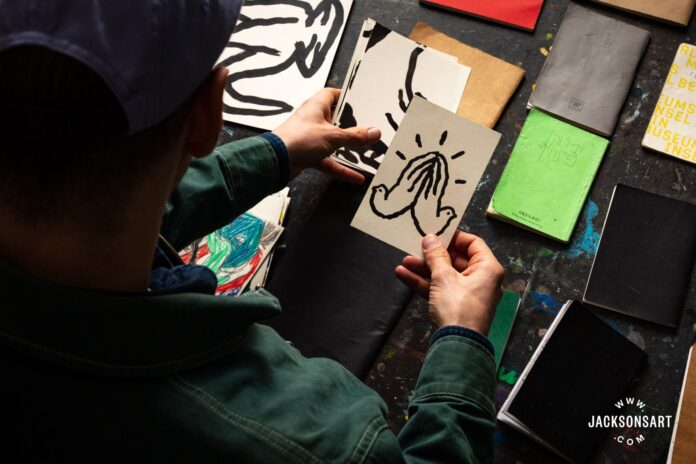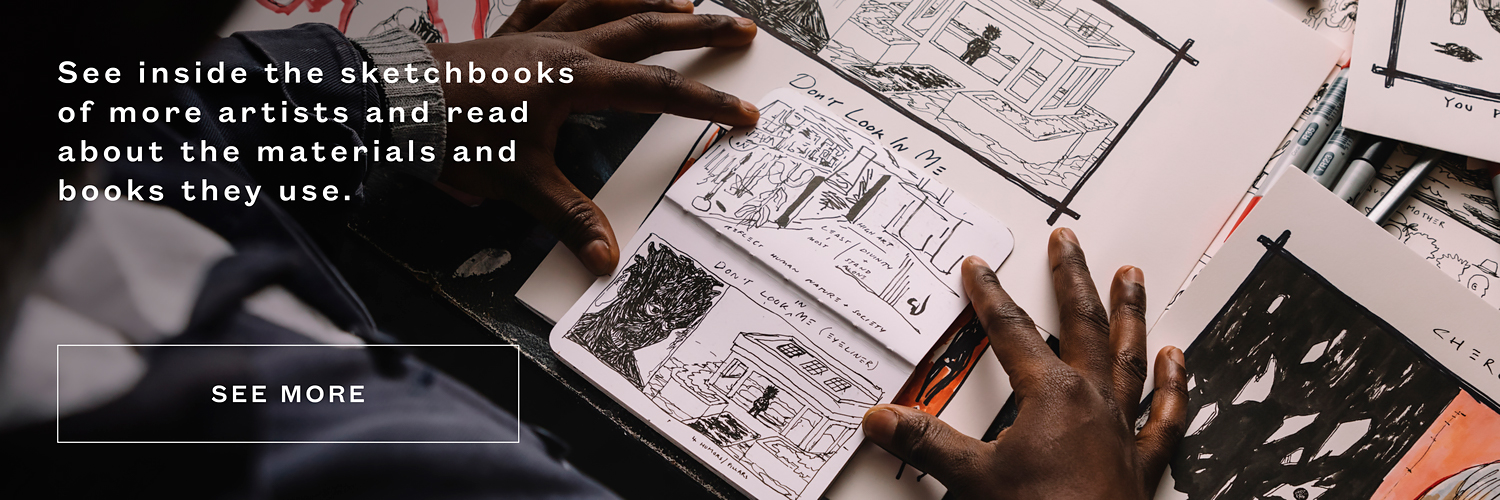Unga is a London-based mixed media artist, and founding member of Broken Fingaz, who for 20 years have been producing monumental-scale murals, sculpture, painting, installation, and animation. Here, Unga shares how the materials he uses allow for the immediacy of his sketchbook practice, as well as some fascinating insights into his process, and Broken Fingaz’s perspective on collectivism in creativity.

Inside the Sketchbook of Unga from Broken Fingaz
I like to use small sketchbooks because they fit in my pouch and I take them everywhere. I go through them very quickly, so I don’t like fancy sketchbooks that make you think too much before you start to draw. The cheaper, the better. The only thing is the paper needs to be not completely white – I like it a bit off-white. I try to finish a sketchbook in a week, just drawing quickly and not thinking too much.

Usually, in very small sketchbooks, I’ll just draw with a pen. Rotring Tikky Graphic Pens are great because the black looks really black. But, they are easier for my kids to destroy, so lately I moved back to the Pilot V7 or V5, as they have a metal nib, which makes me draw a bit quicker. Somehow the rhythm is different.

I like to use old paper. I’ll go to a stationary shop and look for paper that’s been there for 20 years and has become a bit yellow. Then it’s cheaper and it looks much better. Or I’ll take empty pages from old books, so the paper already has character and texture when I start to draw.

I also use black Indian ink and a brush. I prefer the brush to be kind of dead and rough. And I use a lot of wax pastels, which I started doing recently. They capture the energy and the tempo really well. I draw quickly with them and they allow me this rawness. When I draw with one colour over another, there’s a transparency that creates really nice colours. They’re good if you want to do cheerful colours, I would say.

I use sketchbooks to let my brain try out every idea that comes without filtering it, without thinking. If I need an idea, I’ll just take a pen and let the hand move and start drawing. Then suddenly, there will be something that will give me the hint of an idea.

Once I have an idea, I’ll use those sketchbooks to figure out the essence of the composition. I find that the smaller I go, the easier it is to get rid of any details I don’t need. Generally speaking, my goal in art is to be as impactful with as minimal means as possible, so a lot of the work is getting rid of unnecessary things. If the composition works in thumbnail size, it will work as a big work.

I’ll take a piece of paper and divide it into 10 mini squares and try different compositions until I have the right one. I do the same with colours to try different colour combinations. You can also do this in Photoshop, but it’s more fun this way.

If I use one of these small drawings for a big canvas, the challenge is how to adjust it to this different medium and size. It’s a good starting point for the canvas if you have a strong composition, but then you have to understand how to translate it to oil paint. And if it’s two meters by one meter, then obviously the details, the contrast, everything will be different. I almost always come to the canvas with a small composition that I’ve already tried out.

I don’t want to start a canvas knowing exactly how it’s going to look at the end, so it’s about finding this balance between having a starting point, a composition, but then leaving enough room for it to develop as you go. You want to paint, not just create an image. I have to stay attentive the whole time and understand what the painting needs. Sometimes, it will take a left turn and it will look completely different, but for me, it’s still essential to start with a strong composition.

Once I am into a certain theme or medium, I’ll just explore it full-on and create, create, create. I try not to think too much just do, do, do, especially if it’s a new thing for me. Then it’s harder to judge if it’s good or not because I’m not even sure what it is that I’m trying to do. So the only thing I can do is just create a lot. And then I let it sit. And maybe two months later, I will look at it again, and it will be more obvious to see what actually works and what’s not. I find it important to let it sit and have time to look at it with fresh eyes. Especially when trying out new things, because if it’s something I’ve been doing for a while, then I know straight away if there’s something in it.

I find that even if I really try to create something completely different, who I am will come out through the drawings or paintings. Once you understand this, it gives you a sense of freedom because, as an artist, you’re always asking, ‘Wait, is this my style? Is this me?’ I try not to think this way and to trust my instincts as much as I can because that’s pretty much the only thing I have.

Limitations in size and time are good. A lot of the time, if I only have two minutes to make a drawing, it will be better than if I have 20 minutes. And that’s where those sketchbooks come useful, because if I’m drawing someone or something on the bus and it moves, I just have to do it quickly.

Often I’m looking for this place between figurative and abstract. With a still life, for example, I’ll work on the objects and try to find a way to make them more abstract. Sometimes I get stuck and then I use my kids. For example, I will draw a banana and then I will call my daughter and ask her, can you draw it? And she will always do it better, and from an angle I didn’t think of. And then I will draw what she did, so I’m basically stealing her ideas. But, the nice thing is, she is my kid so she cannot sue me because I created her, so I have the copyright.

Both my parents are creative, so it was something that was very much around when I was a child. When I grew up, the rule was you don’t have to go to school if you don’t feel like it, but you can’t stay at home and watch TV, you have to create something. So, it was very natural for me to always draw and to always have a sketchbook.

I sometimes think about when artists die, and on the rare occasion that they’re very successful, then they can leave behind them a lot of things that are worth money for their family. But most of the time, they just leave a headache because it’s piles of stuff that the family now needs to sort out. And they feel bad about throwing it away because they don’t know what the artist cared about or not. So hopefully my work will be worth a lot of money, but in any case, from now on I’m trying to be thoughtful for my family and use small mediums. I also throw a lot away and I’m trying to be more minimalistic in my approach.

Broken Fingaz started as a graffiti crew at the beginning of the millennium. One of the first graffiti crews in the Middle East. Slowly we developed to other mediums, we started doing a lot of posters for music shows, album covers, then paintings, exhibitions, and installations. We do whatever excites us in the moment. We believe that art is something that should be done not only as individuals but as a collective. In music, it’s very normal. Everyone has a band and you don’t even think about it. But somehow with painting, it became this very individual thing, but it doesn’t have to be like this. You can be very creative and still create together and keep your own unique voice.
Working collectively pushes you to places that are hard to reach when you’re working alone. It’s about a whole ecosystem of art, so we will always find ways to collaborate with other artists that we like, whether they be musicians or visual artists. For us, the role of an artist is not only to be in the studio and paint but also to push other artists, to push the culture. And that’s what we’re trying to do.

About Unga of Broken Fingaz
Unga is a self-taught artist and founding member of the internationally acclaimed collective Broken Fingaz, who have emerged from a background in graffiti to present their work in galleries and institutes worldwide. Unga is known for his satirical humour, and psychedelic pop art aesthetic. Embedded in contemporary pop culture, the collective regularly produce artwork for musicians such as Blink 182, U2, Beck, Pearl Jam, The Alchemist, and Kendrick Lamar.
Follow Broken Fingaz on Instagram

Further Reading
Artist Insights: Gemma Berenguer
Brush Pens: The Definitive Guide
The Dark History of the Pencil
Shop Sketchbooks on jacksonsart.com


